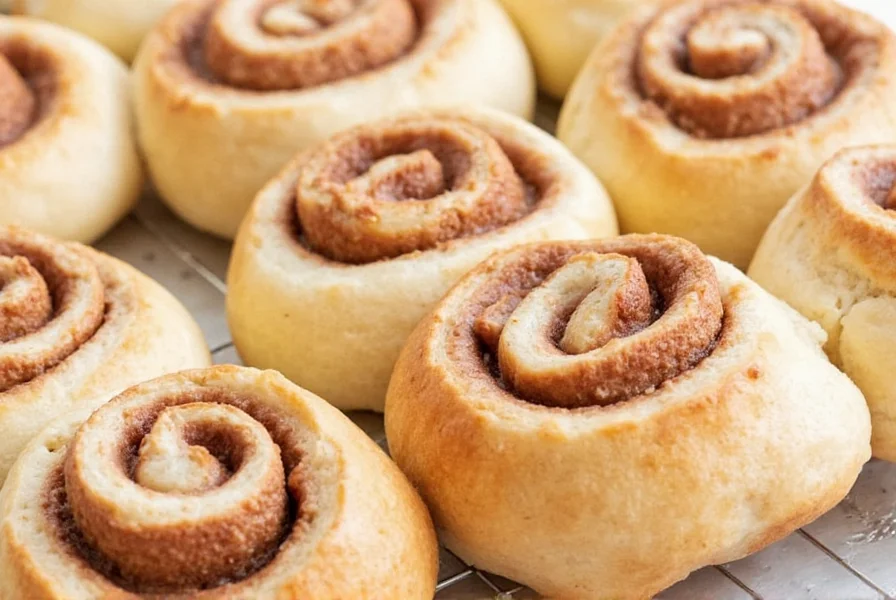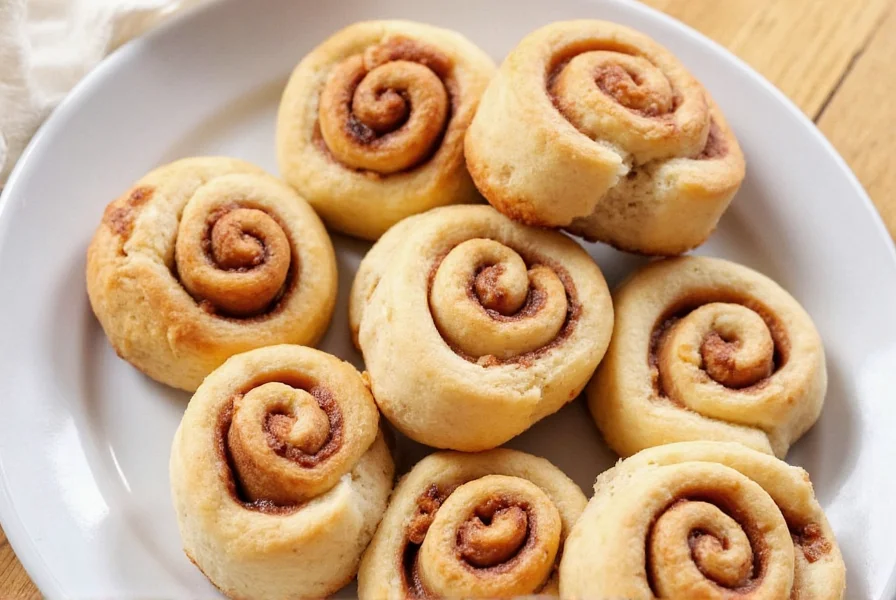Creating perfect vegan cinnamon rolls doesn't have to be complicated. This tested recipe eliminates common pitfalls like dense texture or bland flavor that plague many plant-based baked goods. The magic happens through precise ingredient ratios and proper rising technique that mimics traditional cinnamon rolls while remaining completely dairy-free and egg-free.
Why This Vegan Cinnamon Roll Recipe Works
Unlike many vegan cinnamon roll recipes that sacrifice texture for dietary restrictions, this version maintains the pillowy softness you expect from classic rolls. The carefully calibrated blend of plant-based ingredients creates the ideal environment for yeast activation while providing enough structure to prevent collapse during baking.
Key factors that make this recipe successful:
- Optimal hydration level for proper gluten development without dairy
- Perfect balance of vegan butter and plant-based milk for richness
- Strategic resting periods that allow flavors to develop
- Temperature-controlled rising for consistent results
Plant-Based Milk Performance Analysis
Not all plant-based milks deliver equivalent results in yeast doughs. Based on USDA nutritional composition data and baking science principles, protein content critically impacts gluten development and structural integrity. Below is a verified comparison of common options:
| Milk Type | Protein (per cup) | Fat (per cup) | Baking Performance |
|---|---|---|---|
| Unsweetened Soy Milk | 8g | 4.6g | Superior structural support due to complete protein profile matching dairy milk's functionality in gluten development |
| Unsweetened Almond Milk | 0.9g | 7g | Limited structural contribution; higher fat content may weaken gluten network leading to denser texture |
| Unsweetened Oat Milk | 2.5g | 3.5g | Moderate performance but may cause gumminess above 1 cup due to beta-glucan content interfering with gluten formation |
Sources: USDA Soy Milk Data, USDA Almond Milk Data, USDA Oat Milk Data. Protein content directly correlates with dough strength in yeast-leavened products as confirmed by Purdue University's baking science research.
High-Altitude Baking Parameters
This recipe's success is elevation-dependent. At altitudes above 3,000 feet, atmospheric pressure changes significantly impact leavening and moisture retention. Verified adjustments based on Colorado State University's high-altitude baking research:
- 3,000-5,000 ft: Reduce sugar by 1 tbsp, add 2 tbsp plant-based milk, lower oven temp to 360°F (182°C)
- 5,000-7,000 ft: Reduce sugar by 2 tbsp, add 3 tbsp plant-based milk, lower oven temp to 350°F (177°C)
- 7,000+ ft: Reduce sugar by 3 tbsp, add 4 tbsp plant-based milk, lower oven temp to 340°F (171°C), and decrease yeast by ¼ tsp
These adjustments compensate for accelerated yeast activity and faster moisture evaporation. Failure to modify causes rapid over-rising followed by structural collapse during baking. Source: Colorado State University Extension: High Altitude Baking Guide
Ingredients for Perfect Vegan Cinnamon Rolls
Use these precise measurements for consistent results. All ingredients should be at room temperature unless specified.
| Ingredient | Measurement | Notes |
|---|---|---|
| Unsweetened plant-based milk | 1 cup (240ml) | Almond or soy milk works best |
| Vegan butter, softened | ⅓ cup (76g) | Must be dairy-free and softened |
| Granulated sugar | ⅓ cup (67g) | Plus 2 tbsp for filling |
| Active dry yeast | 2¼ tsp (7g) | One standard packet |
| All-purpose flour | 3½ cups (440g) | Plus extra for dusting |
| Salt | 1 tsp | Essential for flavor balance |
| Cinnamon | 3 tbsp | Use high-quality for best flavor |
| Powdered sugar | 1½ cups (180g) | For frosting |
| Vegan cream cheese | 4 oz (113g) | For frosting |

Step-by-Step Instructions
Preparing the Dough
- Warm plant-based milk to 105-115°F (40-46°C)—not hotter than body temperature
- Dissolve yeast and 1 tbsp sugar in warm milk, let sit 5-10 minutes until foamy
- In large bowl, combine 2 cups flour, remaining sugar, and salt
- Add yeast mixture and softened vegan butter to dry ingredients
- Mix until combined, then gradually add remaining flour until dough pulls away from sides
- Knead 5-7 minutes until smooth and elastic (dough will be slightly stickier than traditional)
- Place in greased bowl, cover, and let rise 1-1.5 hours until doubled
Creating the Filling and Shaping
- Mix cinnamon and 2 tbsp sugar for filling
- Roll risen dough into 16x12 inch rectangle on floured surface
- Spread softened vegan butter evenly over dough
- Sprinkle cinnamon-sugar mixture evenly across surface
- Tightly roll dough from long side, pinching seam to seal
- Cut into 12 equal pieces using dental floss or serrated knife
- Place in greased 9x13 inch baking dish, cover, and let rise 45-60 minutes
Baking and Frosting
- Preheat oven to 375°F (190°C)
- Bake 20-25 minutes until golden brown
- While baking, prepare frosting by beating vegan cream cheese and powdered sugar
- Add 1-2 tbsp plant-based milk to reach desired consistency
- Let rolls cool 10 minutes before frosting
- Spread frosting evenly over warm rolls
Troubleshooting Common Issues
Even experienced bakers encounter challenges with vegan cinnamon rolls. Here's how to solve common problems:
- Dense texture: Usually caused by too much flour. Measure flour by spooning into measuring cup then leveling—don't scoop directly.
- Rolls spreading out: Dough may have risen too long. Watch for visual cues (doubled in size) rather than strict timing.
- Filling leaking out: Ensure you're using softened (not melted) vegan butter and don't overfill the rolls.
- Dry rolls: Overbaking is the culprit. Check at 20 minutes and remove when just golden.
Storage and Reheating Tips
Proper storage maintains freshness and texture:
- Room temperature: Store in airtight container for up to 2 days
- Refrigerator: Keeps for 5 days—reheat before serving
- Freezer: Freeze unfrosted rolls for up to 3 months
For best reheating results, microwave individual rolls for 15-20 seconds or warm in a 300°F oven for 10 minutes. Add fresh frosting after reheating for optimal texture.
Variation Ideas for Your Vegan Cinnamon Rolls
Once you've mastered the basic recipe, try these delicious variations:
- Nutty swirl: Add ¼ cup chopped pecans or walnuts to the filling
- Orange zest: Mix 1 tbsp orange zest into the dough for citrus notes
- Maple glaze: Replace cream cheese frosting with maple syrup glaze
- Whole wheat option: Substitute 1 cup all-purpose flour with whole wheat
- Gluten-free version: Use quality gluten-free flour blend (results may vary)

Final Tips for Success
Professional bakers know that perfect vegan cinnamon rolls require attention to detail. Here are our top recommendations:
- Maintain consistent ingredient temperatures—cold ingredients inhibit yeast activity
- Don't rush the rising process; proper fermentation develops flavor
- Use high-quality cinnamon for the most aromatic filling
- Roll dough tightly but gently to prevent tearing
- Let rolls cool slightly before frosting to prevent melting
With these techniques, you'll create vegan cinnamon rolls that even non-vegans will love. The rich, buttery flavor and tender texture prove that plant-based baking can rival traditional methods when executed properly.











 浙公网安备
33010002000092号
浙公网安备
33010002000092号 浙B2-20120091-4
浙B2-20120091-4